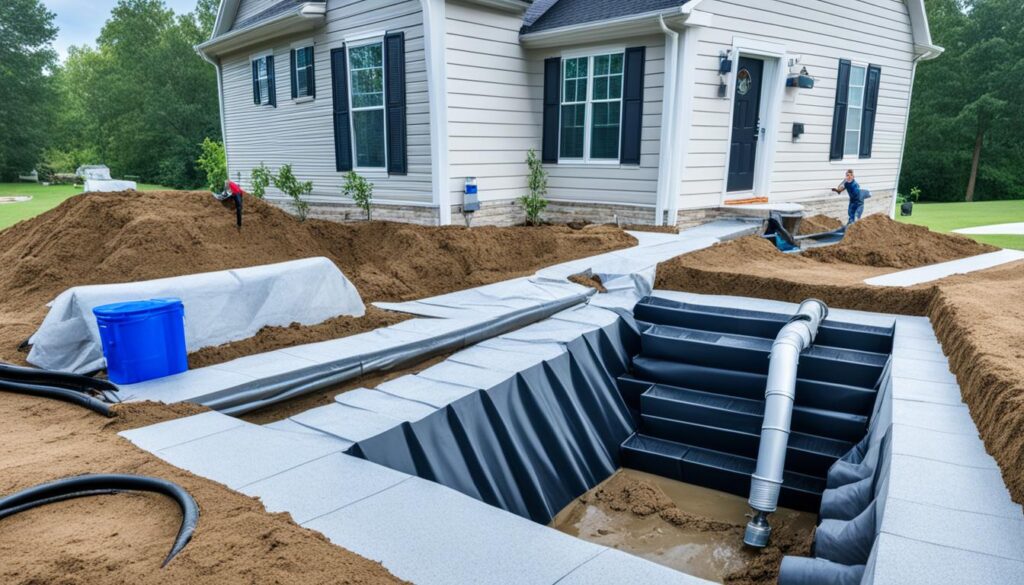Cracking The Code : Navigating the complex landscape of flood insurance can be daunting, but understanding how the costs are calculated is crucial for property owners and homeowners. This article will provide a comprehensive overview of the key factors that influence flood insurance premiums, empowering readers to make informed decisions to protect their investments.
The National Flood Insurance Program (NFIP) serves as the foundation of flood insurance in the United States, playing a vital role in mapping flood zones, assessing risks, and setting the framework for insurance rates. By delving into the NFIP’s processes and the various elements that shape flood insurance costs, we’ll equip readers with the knowledge they need to manage their flood insurance expenses effectively.
From the characteristics of the insured building to the location-specific considerations, this article will explore the intricate web of factors that determine flood insurance rates. Readers will also learn about strategies they can employ, such as mitigation efforts and community involvement, to potentially reduce their flood insurance costs.
Additionally, this article will address the controversial aspects of flood insurance pricing, including the affordability challenges faced by low-income homeowners and the ongoing calls for reform. By providing a balanced perspective, we aim to shed light on the complexities and debates surrounding this critical issue.
Whether you’re a homeowner, property investor, or simply seeking to protect your assets, this comprehensive guide will empower you with the knowledge to navigate the flood insurance landscape effectively. Prepare to dive into the heart of the matter and “crack the code” of flood insurance costs.
Key Takeaways
- The National Flood Insurance Program (NFIP) is the foundation of flood insurance in the United States, responsible for mapping flood zones and assessing risks.
- Flood insurance premiums are influenced by a variety of factors, including the characteristics of the insured building, its location, and the community’s flood mitigation efforts.
- Homeowners and property owners can employ strategies, such as mitigation efforts and community involvement, to potentially reduce their flood insurance costs.
- Affordability challenges and calls for reform in the flood insurance system have sparked ongoing debates, highlighting the need for equitable solutions.
- Understanding the complex mechanisms behind flood insurance costs is crucial for making informed decisions to protect investments and properties.
Understanding the National Flood Insurance Program
The National Flood Insurance Program (NFIP) is the foundation of flood insurance in the United States. Established by the federal government, the NFIP aims to help property owners and communities manage flood risks and protect against financial losses. By providing affordable flood insurance coverage, the program plays a crucial role in the nation’s efforts to mitigate the devastating impacts of flooding.
NFIP: The Foundation of Flood Insurance
The NFIP was created in 1968 to address the growing need for flood protection after a series of devastating natural disasters. Prior to the program’s inception, private insurers were reluctant to offer flood insurance, leaving many property owners vulnerable. The NFIP stepped in to fill this gap, making flood coverage more accessible and affordable for homeowners and businesses across the country.
Mapping Flood Zones and Risk Assessment
A critical aspect of the NFIP’s operations is its role in mapping flood zones and assessing flood risks. The Federal Emergency Management Agency (FEMA) is responsible for conducting detailed studies and creating Flood Insurance Rate Maps (FIRMs) that identify areas prone to flooding. These maps, which are continuously updated, serve as the foundation for determining flood insurance rates and the level of coverage required for properties in high-risk flood zones.
By understanding the NFIP’s flood mapping and risk assessment processes, property owners and floodplain managers can better navigate the complexities of flood insurance and make informed decisions to protect their investments. This knowledge, in turn, helps communities develop effective floodplain management strategies and participate in the NFIP’s initiatives to reduce flood risks.
Factors Influencing Flood Insurance Premiums
When it comes to flood insurance, the cost of premiums can vary significantly based on a variety of factors. Understanding these key considerations is crucial for homeowners and property owners to effectively manage their flood risk and make informed decisions about their insurance coverage.
Building Characteristics: Age, Construction, and Elevation
The characteristics of the insured building play a pivotal role in determining flood insurance premiums. The age and construction materials of a structure can greatly impact its vulnerability to flood damage. Older buildings or those made with less flood-resistant materials may face higher premiums than newer, more resilient properties. Additionally, the elevation of a building in relation to the surrounding flood zone is a critical factor, as properties at higher elevations typically have a lower flood risk and may qualify for reduced insurance costs.
Homeowners and property owners can take proactive steps to mitigate their flood risk and potentially lower their insurance premiums. This may involve retrofitting or elevating the building, using more flood-resistant construction materials, or implementing other flood mitigation measures approved by the Federal Emergency Management Agency (FEMA).
Location, Location, Location: Flood Zone and Community Rating
The location of a property, particularly its proximity to designated flood zones, is a significant factor in determining flood insurance rates. Properties located in high-risk flood areas, as identified by FEMA‘s Flood Insurance Rate Maps (FIRMs), typically face higher premiums. However, the Community Rating System (CRS) program, managed by the NFIP, provides discounts on flood insurance for communities that implement comprehensive floodplain management and mitigation efforts.
By understanding the flood zone designation of their property and the flood mitigation initiatives within their local community, property owners can gain valuable insights into the factors influencing their insurance costs. Engaging with their floodplain manager and staying informed about the NFIP‘s policies and community rating system can help them identify opportunities to reduce their flood insurance premiums.

Cracking the Code: Decoding Flood Insurance Rates
As homeowners and property owners navigate the complexities of flood insurance, understanding the intricate mechanisms behind rate calculations is crucial. At the heart of this process lie FEMA’s Flood Insurance Rate Maps (FIRMs), which serve as the foundation for assessing flood risks and determining the appropriate insurance premiums.
FEMA’s Flood Insurance Rate Maps (FIRMs)
FEMA’s FIRMs are detailed maps that delineate areas with varying degrees of flood hazard and natural hazards. These maps provide essential information about the flood-prone regions, enabling insurers and homeowners to make informed decisions regarding flood insurance and protection. The flood insurance rate is largely dependent on the elevation of a property and its location relative to the designated flood zones.
Elevation Certificates and Premium Calculations
Closely tied to the FIRMs are elevation certificates, which play a critical role in the insurance premiums calculation process. These documents provide detailed information about a property’s flood risk and vulnerability, including its floor elevation in relation to the base flood elevation. Insurers and floodplain managers use this data to determine the appropriate flood insurance rate for a given property, taking into account the risk factor and the floodplain management efforts in the community.
By understanding the pivotal role of FIRMs and elevation certificates, homeowners and property owners can gain a deeper insight into the factors that determine their flood insurance premiums. This knowledge empowers them to make informed decisions, reduce their insurance costs, and improve the overall flood protection for their investments.

Homeowner Responsibilities in Flood Insurance
As a homeowner, you play a critical role in managing your flood insurance costs and protecting your property from the devastating effects of flooding. Two key responsibilities you should prioritize are maintaining accurate property information and proactively mitigating flood risks through proper maintenance.
Maintaining Accurate Property Information
Ensuring that your property information is up-to-date and accurate is essential for determining accurate insurance premiums. This includes maintaining a current elevation certificate, which provides critical data about your home’s flood risk and vulnerability. Regularly reviewing and updating this documentation can help you secure the most favorable flood insurance rates and ensure that your coverage accurately reflects the true risk of your property.
Mitigating Flood Risks Through Proper Maintenance
As a homeowner, you have the power to mitigate flood risks and potentially lower your insurance premiums. Proper maintenance of your property, such as keeping drainage systems clear, ensuring the structural integrity of your home, and implementing flood-proofing measures, can significantly reduce your flood risk. By taking these proactive steps, you demonstrate to your insurance agency and the Federal Emergency Management Agency (FEMA) that you are committed to protecting your property and minimizing the potential for flood damage.
Remember, your actions as a homeowner can have a direct impact on the cost of your flood insurance. By maintaining accurate property information and actively mitigating flood risks, you can not only safeguard your investment but also potentially save money on your insurance premiums. Engaging with your local floodplain manager and floodplain management efforts can further enhance your understanding of your flood risk and the steps you can take to reduce it.

The Role of Insurance Agents and Brokers
In the intricate landscape of flood insurance, the role of insurance agents and brokers cannot be overstated. These professionals serve as vital intermediaries, guiding property owners through the complexities of the National Flood Insurance Program (NFIP) and ensuring they receive the coverage they need at the most favorable rates possible.
Navigating the NFIP Policies and Rates
The NFIP is a labyrinth of policies, regulations, and eligibility requirements, making it challenging for the average homeowner or business owner to navigate on their own. Insurance agents and brokers are the experts who can help their clients decipher the factors that influence flood insurance rates, such as flood zone designations, building characteristics, and community-level flood mitigation efforts. By understanding these nuances, they can guide their clients in selecting the right policy and coverage levels to meet their specific protection needs and budget concerns.
Advocating for Clients’ Best Interests
Beyond simply facilitating the purchase of flood insurance, the best agents and brokers go the extra mile to advocate for their clients’ best interests. They work diligently to ensure their clients receive the most accurate risk assessment and are given access to discounts and mitigation options that can help lower their insurance premiums. These professionals stay up-to-date on the latest NFIP regulations, federal emergency management initiatives, and industry trends, allowing them to provide their clients with the most comprehensive and cost-effective flood coverage.
Ultimately, the role of insurance agents and brokers in the flood insurance landscape is one of vital importance. By leveraging their expertise and advocating for their clients’ needs, they can help property owners navigate the complex world of flood insurance and secure the protection they require to safeguard their investments, communities, and livelihoods.

Flood Insurance Options for High-Risk Areas
For property owners in high-risk flood areas, the standard National Flood Insurance Program (NFIP) policies may not provide sufficient coverage or may come at a prohibitively high cost. In such cases, exploring private flood insurance alternatives and excess flood insurance can offer additional protection and potentially more favorable premiums.
Private Flood Insurance Alternatives
The private flood insurance market has expanded in recent years, providing homeowners and property owners with more options beyond the NFIP. These private policies can offer higher coverage limits, more comprehensive protection, and in some cases, lower premiums compared to NFIP plans, especially for properties in high-risk flood zones. By working with insurance agents and brokers, property owners can navigate the private flood insurance landscape and find the coverage that best suits their needs and budget.
Excess Flood Insurance for Higher Coverage Limits
In addition to private flood insurance options, excess flood insurance can be a valuable tool for property owners who require higher coverage limits than what the NFIP provides. This type of policy is designed to supplement the NFIP plan, offering additional protection for properties with greater flood risks or higher values. By combining an NFIP policy with an excess flood insurance policy, property owners can ensure they have the necessary coverage to protect their investments and mitigate the financial impact of a major flood event.
As property owners in high-risk flood areas evaluate their options, it is crucial to work closely with insurance professionals, floodplain managers, and community leaders to determine the most suitable flood insurance coverage for their unique circumstances. By exploring alternative solutions and tailoring their policies to their specific needs and risks, property owners can effectively manage their flood insurance costs and protect their valuable investments.
Saving Money on Flood Insurance Premiums
As homeowners and property owners grapple with the rising costs of flood insurance, it’s essential to explore strategies that can help reduce their premiums. Two key areas of focus are flood-proofing and mitigation techniques, as well as leveraging the Community Rating System discounts offered through the National Flood Insurance Program (NFIP).
Flood-Proofing and Mitigation Techniques
Implementing effective flood-proofing and mitigation measures can significantly lower the perceived flood risk associated with a property, ultimately leading to lower insurance premiums. Homeowners can consider elevating their structures, installing flood barriers, and improving drainage systems to minimize the impact of potential flooding events. These proactive steps not only protect the property but also demonstrate to insurers that the risk of flood damage has been reduced, resulting in more favorable rates.
Community Rating System Discounts
Another valuable strategy for saving on flood insurance premiums is to take advantage of the Community Rating System (CRS) offered by the NFIP. The CRS is a voluntary program that recognizes and incentivizes communities that implement comprehensive floodplain management and mitigation efforts. By participating in the CRS and implementing best practices, such as improving flood mapping, enhancing emergency preparedness, and promoting public awareness, communities can earn discounts on NFIP policies for their residents. These discounts can range from 5% to 45%, providing significant savings for homeowners and property owners within the participating communities.
By proactively addressing flood risks through structural and community-level mitigation measures, property owners can not only safeguard their investments but also unlock substantial savings on their flood insurance premiums. Collaboration with local floodplain managers, NFIP representatives, and insurance experts can help homeowners and businesses navigate the complexities of flood insurance and identify the most effective strategies to reduce their costs.

| Flood Mitigation Techniques | Potential Premium Savings |
|---|---|
| Elevating structure | Up to 60% |
| Installing flood barriers | Up to 40% |
| Improving drainage systems | Up to 30% |
| Participating in Community Rating System | 5% to 45% |
Controversial Aspects of Flood Insurance Pricing
While the National Flood Insurance Program (NFIP) and associated policies have been instrumental in protecting property owners from the financial devastation of floods, the issue of flood insurance affordability has become a growing concern, particularly for low-income homeowners. The high premiums associated with flood insurance in high-risk flood zones can present significant challenges for vulnerable communities and property owners.
Affordability Challenges for Low-Income Homeowners
In many flood-prone areas, the cost of flood insurance can be disproportionately burdensome for low-income homeowners. The premiums are often tied to the flood risk and property value, which can result in unaffordable rates for those with limited financial resources. This issue has sparked concerns about the potential for displacement and financial hardship, as some homeowners may be forced to choose between paying for flood coverage or meeting other essential living expenses.
Also Read : What’s The Cost Of Not Having Renters Insurance?
Calls for Reform and Risk Communication Improvements
In response to the affordability challenges, there have been growing calls for reforms to the flood insurance system. Stakeholders, including policymakers, community leaders, and advocacy groups, have advocated for measures to improve the accessibility and equity of flood insurance, such as means-tested subsidies, alternative financing options, and enhanced risk communication. The goal is to ensure that flood protection and risk mitigation strategies are not out of reach for vulnerable homeowners and communities.
As the debate surrounding flood insurance affordability continues, it is crucial that policymakers, insurance agencies, and federal emergency management authorities work collaboratively to address these complex issues. By finding innovative solutions and improving risk communication, the flood insurance system can become more inclusive and responsive to the needs of all property owners, regardless of their economic status or location.

Conclusion
As we conclude this comprehensive exploration of how flood insurance costs are calculated, it’s clear that navigating the complex landscape of the National Flood Insurance Program (NFIP), flood zone mapping, and property characteristics is crucial for homeowners and property owners. The factors that influence flood insurance premiums, such as building age, construction materials, elevation, and location within designated flood zones, play a critical role in determining the cost of coverage.
Throughout this article, we’ve emphasized the importance of proactive measures, including mitigation efforts and community involvement, as homeowners can actively manage and potentially reduce their flood insurance expenses. Strategies like elevating structures, implementing drainage improvements, and participating in the Community Rating System have demonstrated the power of individual and collective actions in shaping more affordable flood insurance premiums.
However, the article has also shed light on the ongoing challenges and calls for reform within the flood insurance landscape, particularly regarding affordability and equity concerns for low-income homeowners. As stakeholders continue to address these complex issues, it’s essential for property owners to stay informed, engage with their local authorities and insurance experts, and advocate for solutions that ensure accessible and fair flood insurance coverage for all.
By understanding the intricate factors that influence flood insurance costs and the available strategies to manage them, readers can make informed decisions to protect their properties, investments, and financial well-being in the face of the growing threat of flooding. As we navigate the evolving flood insurance landscape, the insights gained from this article can empower property owners to navigate the NFIP, leverage mitigation techniques, and work collaboratively with their communities to build a more resilient and sustainable future.
FAQs
Q: What is FEMA and how does it relate to flood insurance costs?
A: FEMA stands for the Federal Emergency Management Agency and plays a key role in flood insurance. They are the agency responsible for mapping flood zones and establishing insurance rates based on flood risk in different areas.
Q: How does an insurance agency calculate flood insurance costs?
A: Flood insurance costs are calculated based on various factors such as the property’s location, its susceptibility to flooding, the building’s structure and contents, and the desired coverage amount.
Q: What should I do if my flood insurance premiums increase?
A: If your flood insurance premiums increase, you can reach out to your insurance provider to discuss the reasons for the increase. You can also inquire about potential discounts or mitigation strategies to lower your costs.
Q: How does the location of a property impact flood insurance costs?
A: The location of a property is a key factor in determining flood insurance costs. Properties located in high-risk flood zones are likely to have higher insurance premiums compared to those in low-risk areas.
Q: Can renters buy flood insurance for their belongings?
A: Yes, renters can purchase flood insurance to protect their belongings in case of a flood. This type of insurance is separate from a landlord’s flood insurance policy that covers the building structure.
Q: What factors contribute to the variation in flood insurance costs?
A: Flood insurance costs vary depending on factors such as the property’s location, the flood risk in that area, the building’s structure and contents, the desired coverage amount, and any mitigation measures in place.
Q: How does the economic impact of flooding affect flood insurance costs?
A: The economic impact of flooding, such as damage to infrastructure and property, can influence flood insurance costs. Higher flood risk areas may experience increased insurance premiums to account for potential damages.




